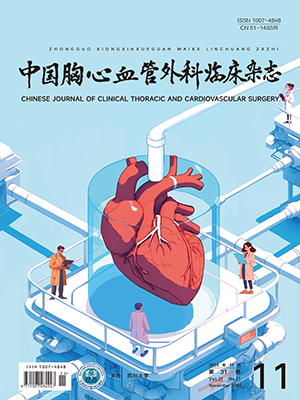| 1. |
Enriquez-Sarano M, Akins CW, Vahanian A. Mitral regurgitation. Lancet, 2009, 373 (9672):1382-1394.
|
| 2. |
Baskett RJ, Exner DV, Hirsch GM, et al. Mitral insufficiency and morbidity and mortality in left ventricular dysfunction. Can J Cardiol, 2007, 23 (10):797-800.
|
| 3. |
Borghetti V, Campana M, Scotti C, et al. Biological versus prosthetic ring in mitral-valve repair:enhancement of mitral annulus dynamics and left ventricular function with pericardial annuloplasty at long term. Eur J Cardiothorac Surg, 2000, 17 (4):431-439.
|
| 4. |
Ben Zekry S, Lang RM, Sugeng L, et al. Mitral annulus dynamics early after valve repair:preliminary observations of the effect of resectional versus non-resectional approaches. J Am Soc Echocardiogr, 2011, 24 (11):1233-1242.
|
| 5. |
Suri RM, Aviernos JF, Dearani JA, et al. Management of less-than-severe mitral regurgitation:should guidelines recommend earlier surgical intervention? Eur J Cardiothorac Surg, 2011, 40 (2):496-502.
|
| 6. |
张宝仁, 朱家麟, 主编.人造心脏瓣膜与瓣膜置换术.北京:人民卫生出版社, 1999.202-221.
|
| 7. |
Khoo NS, Smallhorn JF. Mechanism of valvular regurgitation. Curr Opin Pediatr, 2011, 23 (5):512-517.
|
| 8. |
Poglajen G, Harlander M, Gersak B. Ex vivo study of altered mitral apparatus geometry in functional mitral regurgitation. Heart Surg Forum, 2010, 13 (3):E172-E176.
|
| 9. |
Komeda M, Kitamura H, Fukaya S, et al. Surgical treatment for functional mitral regurgitation. Circ J, 2009, 73 (Suppl A):A23-A28.
|
| 10. |
Wan CK, Suri RM, Li Z, et al. Management of moderate functional mitral regurgitation at the time of aortic valve replacement:is conco-mitant mitral valve repair necessary? J Thorac Cardiovasc Surg, 2009, 137 (3):635-640.
|
| 11. |
Mallidi HR, Pelletier MP, Lamb J, et al. Late outcomes in patients with uncorrected mild to moderate mitral regurgitation at the time of isolated coronary artery bypass grafting. J Thorac Cardiovasc Surg, 2004, 127 (3):636-644.
|
| 12. |
Najm HK, Arifi AA, Omran AS, et al. Moderate ischemic mitral regurgitation:Is there a case for early intervention? J Saudi Heart Assoc, 2010, 22 (3):115-119.
|
| 13. |
Hetzer R, Delmo Walter EM. No ring at all in mitral valve repair:indications, techniques and long-term outcome. Eur J Cardiothorac Surg, 2014, 45 (2):341-351.
|
| 14. |
Nardi P, Pellegrino A, Olevano C, et al. Mitral valve repair for the treatment of degenerative mitral valve disease with or without prosthetic ring annuloplasty:long-term outcomes. J Cardiovasc Surg (Torino), 2013, 54 (2):305-312.
|
| 15. |
Detter C, Aybek T, Kupilik N, et al. Mitral valve annuloplasty:comparison of the mural annulus shortening suture (MASS)with the Carpentier-Edwards prosthetic ring. J Heart Valve Dis, 2000, 9 (4):478-486.
|
| 16. |
Aybek T, Risteski P, Miskovic A, et al. Seven years' experience with suture annuloplasty for mitral valve repair. J Thorac Cardiovasc Surg, 2006, 131 (1):99-106.
|
| 17. |
Fundarò P, Tartara PM, Villa E, et al. Mitral valve repair:is there still a place for suture annuloplasty? Asian Cardiovasc Thorac Ann, 2007, 15 (4):351-358.
|
| 18. |
Alfieri O, De Bonis M. The role of the edge-to-edge repair in the surgical treatment of mitral regurgitation. J Card Surg, 2010, 25 (5):536-541.
|
| 19. |
李进华, 来永强, 王炯, 等. "缘对缘"二尖瓣成形术对左心室舒张功能的影响.中国胸心血管外科临床杂志, 2009, 16 (5):344-347.
|
| 20. |
Santana O, Lamelas J. Minimally invasive transaortic repair of the mitral valve. Heart Surg Forum, 2011, 14 (4):e232-e236.
|
| 21. |
Källner G, van der Linden J, Hadjinikolaou L, et al. Transaortic approach for the Alfieri stitch. Ann Thorac Surg, 2001, 71 (1):378-380.
|
| 22. |
Tsutsumi Y, Numata S, Seo H, et al. Transaortic edge-to-edge mitral valve repair and left ventricular myectomy. Gen Thorac Cardiovasc Surg, 2013, 61 (4):223-225.
|
| 23. |
Santana O, Lamelas J. Minimally invasive transaortic mitral valve repair during aortic valve replacement. Tex Heart Inst J, 2011, 38 (3):298-300.
|
| 24. |
Hosseini MT, Chandrasekaran V. Transaortic mitral valve repair in double valve infective endocarditis. J Card Surg, 2010, 25 (6):651-653.
|




